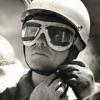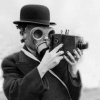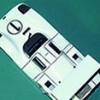With the evidence of nose/tail colour coding being applied 'in the field', the explanations suggested thus far become ever less convincing.
At least we can be fairly sure it isn't a 'novice cross'...
So, they quite possibly had coloured paints on hand, but didn't have enough orange left for a patch on the flank? But if so, differentiating a 'substitute' for orange only applies if there was a yellow-coded car at the same race.
Seems just as likely that the red could be confused with the orange, especially in the half-light - so if no orange was available, why not leave it plain yellow? Or blank? For the quartet modelled in the pic linked by funformula, yellow would have a been a more sensible choice that orange for the nose and tail to start with (even allowing for colour shift in photos or the accuracy of the models - note the Shell emblems, which are presumably the correct red).
As for making the yellow 'stand out' more from the white... that simply doesn't work - the presence of the black merely reduces the perceived contrast between the yellow and white and makes the colour less prominent. (You can test this by putting contrasting outlines around patches of colour over similarly-coloured backgrounds.) And if the yellow side patch becomes less visible, so what? The one with no apparent patch is 'the other car'. That would be more sensible than trying to use another colour.
If this anomaly was based purely on the actual colours used, then it may suggest that Porsche didn't quite know what they were doing, or were not as well-sorted as perceived wisdom suggests. In more general terms, given the SM/Arch anecdotes given above Rob (the Arch one I've heard several times before) and other accounts, such as those in Mark Donohue's book, I wouldn't entirely dismiss that.
Are the vertical tail fins (supporting the rear wing) actually separate from the tail section (eg. sort of like the bolt-on arches on the original 911 GT2)? If so, maybe that car is using a spare tail section. Did it start the race with that labelling? Seems unlikely that they'd dismantle and reassemble a tail section and adjustable wing during the race, rather than having a complete one ready. And that still doesn't explain why they'd have a spare thus labelled rather than leave it blank until used. Unless they just had some unfounded ideas about colours.
I call this, as yet, unsolved.
Edited by 2F-001, 24 June 2015 - 07:51.
























